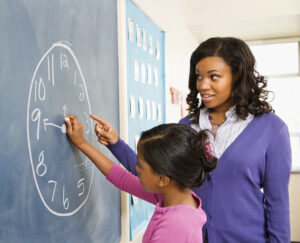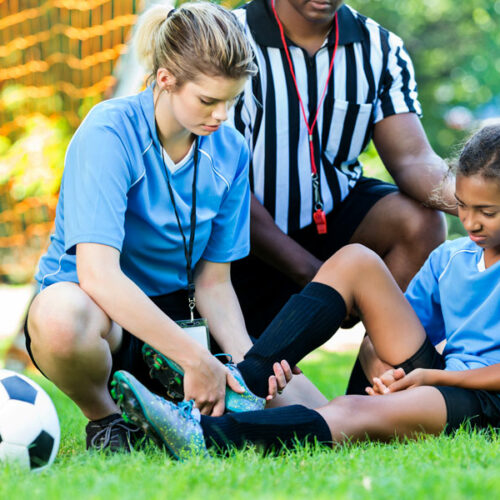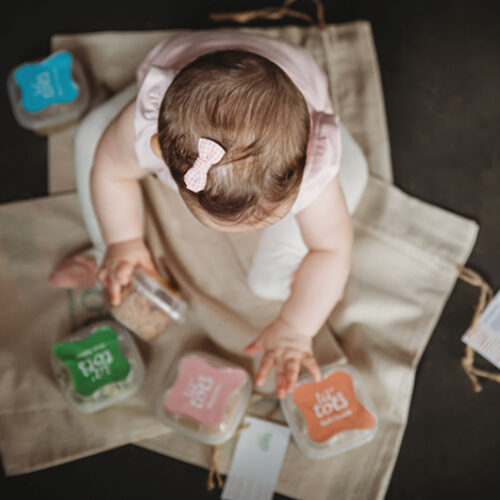Teaching kids to tell the time

Learning to tell time is a key skill that helps your child throughout life. It can be approached in a sequenced way, making it easier for both parents and kids.
To us adults, telling the time is so straightforward, we barely think about it. However, when you break it down to explain to kids, you’ll see how complicated it actually is. There are a variety of skills involved, as well as an understanding of the concept that time passes. Thankfully, there’s a tried and tested way to teach your child, so don’t worry!
When to start
Around six years of age, children begin to become aware of time itself. They’ll notice a difference between what happened before, what’s happening now and what will happen. Your little one may start to grasp being told, “Not now, but later”. These are signs that they’re ready to learn how to tell the time. Don’t stress if they don’t get it straight away – this is a slow and gentle process that may take a couple of years to complete.
Fundamentals
Before introducing them to an analogue clock, it’s best to ensure that your child has a broad idea of what time is. They don’t have to understand anything complicated. All that’s needed is a basic grasp of the units of time and that time passes. Tell your child about minutes, hours, days, morning, evening and night. They’ll probably have heard these words before more casually, but do still discuss the concepts.
Over the next while, include these ideas when chatting and when making plans with your little one. If you say “We’ll do that tomorrow morning”, explain what that means. When that time comes, discuss that time has passed and check if they can remember you telling them “tomorrow morning”. It may take kids a while to get used to this, so don’t worry if they’re a little lost at first. Encouragement is key!
Maths skills
In order to learn how to tell the time, your little one will need some knowledge of maths. Although you won’t be starting with the smallest divisions, it’s helpful for them to be able to count from 1 to 12, for the hours, and 0 to 60 for the minutes. Alongside this, they’ll have to be able to recognise and read these numbers. It can be challenging at the beginning but it will make everything easier for them in the next stages – where you’ll be focusing on the hands of the clock and different ways to break down the clock face into segments.
Big hand, little hand
All analogue clocks have a big hand and a little hand. Lots of children mix them up or aren’t sure which one is which. Tell your child that the ‘little hand’ – which is the one that is noticeably shorter – points to hours. Then explain to them that the ‘big hand’ – which is the long, slim one – points to minutes. Once they are able to read the different numbers, you can ask them to call out which number the big hand is pointing to, for example. They will make mistakes, and that’s completely normal. When this happens, encourage them to keep trying and gently point out the correct answer.
Break it down
Once kids can tell the two clock hands apart, it’s good to work on the clock segments. Show your little one that when the minute hand is at 30, it’s halfway around the clock face and is splitting it in two. You can also point out that 30 is half of 60, and that 30 minutes equals half an hour. With these facts on board, teach your child that when the minute hand moves from the top of the clock to 30, this means half an hour has passed. As soon as they’re comfortable with this, they will be more able to combine this information with what they can see the big hand is pointing at. The final step is for them to be able to say that when the small hand is pointing to the number 2 and the big hand is pointing to 30, that the time is half past two.
One key thing to note here is that many children get confused by the hour hand not pointing directly at 2, when the time is half past two. You can link this back to the passage of time and show that as the minute hand whizzes around the clock, the hour hand slowly but steadily moves from one number to the next.
Building blocks
This process leads to breaking the clock face down into smaller segments. They can apply their previous knowledge and learn that as the big hand moves towards 30, it stops at 15, and this is a quarter of the whole clock. You can label the right side of the clock face ‘past’ and the left side ‘to’, and over time they will be able to use all of this information to identify ‘a quarter past’ and ‘a quarter to’.
The same method can be used to get to a place where your child can see the clock’s 5-minute sections and even each individual minute. Use all of the previous lessons as building blocks and don’t put any pressure on your child to progress quickly. Again, it can take a few years for your little one to gain this skill and be comfortable telling the time.
Keep it fun
Don’t be afraid to make a game of it, as you find natural ways in the day to quiz your child. There are plenty of educational toy clocks that bring an element of fun into this process. You can even set up challenges by saying things like, “Meet me back here at twenty-three minutes past four for a surprise”.
As always, it’s best to keep things light and enjoyable where possible and to be patient. With practice, positivity and consistency, your little one will soon be a whizz at reading the clock!
Image Credit: ShutterStock












Comments